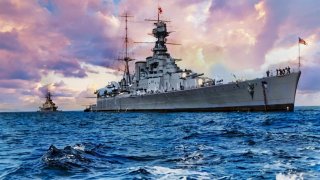HMS Hood: The Battlecruiser That Changed Naval History Forever
The HMS Hood, the Royal Navy's pride, epitomized British naval power but met a tragic end during WWII against the German battleship Bismarck.
Summary: The HMS Hood, the Royal Navy's pride, epitomized British naval power but met a tragic end during WWII against the German battleship Bismarck. Despite being a formidable battlecruiser with advanced armament and armor, a fatal hit from Bismarck led to its sinking in the Denmark Strait, with nearly all hands lost. This event underscored the vulnerability of even the most advanced warships and had a profound impact on British morale, prompting a relentless hunt for the Bismarck, which was subsequently sunk, avenging the Hood.
Introducing HMS Hood
Laid down in 1916, the HMS Hood was a massive ship. One of the Royal Navy’s flagships, she was more fast battleship than battlecruiser. Yet none of this saved the Hood from sinking under the guns of the German battleship Bismarck in one of the Royal Navy’s darkest days of the Second World War.
The Hood was the first of the Royal Navy’s Admiral class of battlecruisers. This class was conceived in response to the Imperial German Navy’s Mackensen-class battlecruisers, the last German ships built during the First World War. These ships were apparently larger and more heavily armed than the British battlecruisers in service at the time, turning the Admiralty’s attention to the design of the Hood.
The Admiral class was much larger than its predecessors. At 806 feet long and displacing more than 47,000 tons, this was a big boat. Four boilers with associated steam turbines produced 150,000 shaft horsepower, enough to propel the Hood along at an astonishing 32 knots.
For armament, the Hood carried eight 15-inch guns in four pairs of twin turrets. These turrets were hydraulically operated and had main and backup fire control directors. In addition, the Hood mounted twelve 5.5-inch guns, although these were removed in a 1940 refit. Other armaments included anti-aircraft cannons and torpedo tubes.
During the Hood’s construction, the Royal Navy engaged the Imperial Navy in the Battle of Jutland, the only major fleet action of the First World War. Lessons learned from this battle caused designers to add armor to the Hood, particularly belts along the length of the ship. This added weight caused the Hood to ride low in the water, where heavy seas routinely washed across the foredeck and into vents, flooding mess decks and berthings and earning her the moniker “the largest submarine in the Navy.”
Operational History
The Hood was not commissioned until August 1918, too late to see any real action in the First World War. The interwar years provided plenty of opportunity for service, however – the Hood served as the flagship of the battlecruiser squadron.
In 1923, she completed a circumnavigation, stopping at many British holdings such as Australia, New Zealand, and Canada in an effort to remind them of the power of the British Navy and encourage commitment to the cause in the form of money and ships. Also during this period, the Hood underwent several major refits. The Admiralty planned another refit for 1941 to improve her deck armor, increase her armaments, and modernize her propulsion system. The outbreak of the Second World War delayed this refit indefinitely, and that delay may have contributed to her demise.
HMS Hood Sinking
The Hood was active from the start of the war, participating in the sinking of the French fleet at Mers-el-Kébir and hunting commerce raiders in the North Atlantic. Her final major action was the Battle of the Denmark Strait, an attempt to contain the breakout of the superheavy German battleship Bismarck into the Atlantic. Both ships were joined by escorts, the Hood by the newly commissioned battleship Prince of Wales, and the Bismarck by the heavy cruiser Prinz Eugen. Upon intercepting the German ships, the British ships began closing the distance, firing all the while.
Ten minutes into the engagement, the Hood began a turn to port to bring her aft guns to bear. While in this turn, she was struck by a shell from the Bismarck that detonated in her ammo stores. A massive explosion followed, and the Hood sank in three minutes with the loss of almost all of her 1,421 crew. Only three men survived.
Although her loss was a major blow to British morale, it evinced a strong response. The Bismarck, one of the largest battleships ever built, was sunk three days later.
About the Author: Maya Carlin
Maya Carlin, National Security Writer with The National Interest, is an analyst with the Center for Security Policy and a former Anna Sobol Levy Fellow at IDC Herzliya in Israel. She has by-lines in many publications, including The National Interest, Jerusalem Post, and Times of Israel. You can follow her on Twitter: @MayaCarlin.
Email the author: [email protected].
Image Credit: Creative Commons.


